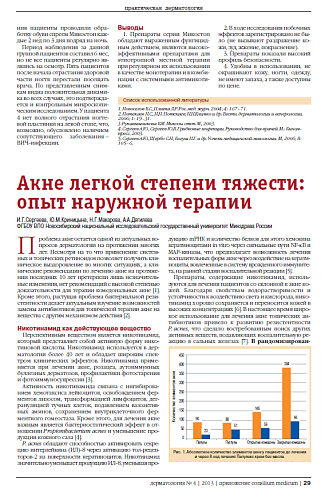Материалы доступны только для специалистов сферы здравоохранения.
Чтобы посмотреть материал полностью
Авторизуйтесь
или зарегистрируйтесь.
Акне легкой степени тяжести: опыт наружной терапии
Акне легкой степени тяжести: опыт наружной терапии
Материалы доступны только для специалистов сферы здравоохранения.
Чтобы посмотреть материал полностью
Авторизуйтесь
или зарегистрируйтесь.
Аннотация
И.Г.Сергеева, Ю.М.Криницына, Н.Г.Макарова, А.А.Дягилева
ФГБОУ ВПО Новосибирский национальный исследовательский государственный университет Минздрава России
ФГБОУ ВПО Новосибирский национальный исследовательский государственный университет Минздрава России
Полный текст
Список литературы
1. Nast A, Dreno B, Bettoli V et al. European evidence-based (S3) guidelines for the treatment of acne. J Eur Acad Dermatol Venereol 2012; 26 (1): 1–29.
2. Schafer F, Fich F, Lam M et al. Antimicrobial susceptibility and genetic characteristics of Propionibacterium acnes isolated from patients with acne. Int J Dermatol 2013; 52 (4): 418–25.
3. Surjana D, Damian DL. Nicotinamide in dermatology and photoprotection. Skinmed 2011; 9 (6): 360–5.
4. Fivenson DP. The mechanisms of action of nicotinamide and zinc in inflammatory skin disease. Cutis 2006; 77 (1): 5–10.
5. Grange PA, Raingeaud J, Calvez V, Dupin N. Nicotinamide inhibits Propionibacterium acnes-induced IL-8 production in keratinocytes through the NF-kappaB and MAPK pathways. J Dermatol Sci 2009; 56 (2): 106–12.
6. Namazi MR. Nicotinamide-containing sunscreens for use in Australasian countries and cancer-provoking condition. Med Hypotheses 2003; 60 (4): 544–5.
7. Shalita AR, Smith JG, Parish LC et al. Topical nicotinamide compared with clindamycin gel in the treatment of inflammatory acne vulgaris. Int J Dermatol 1995; 34 (6): 434–7.
8. Бутарева М.М., Знаменская Л.Ф., Каппушева И.А. и др. Принципы комбинированной терапии акне. Вестн. дерматологии и венерологии. 2011; 6: 13–7./
2. Schafer F, Fich F, Lam M et al. Antimicrobial susceptibility and genetic characteristics of Propionibacterium acnes isolated from patients with acne. Int J Dermatol 2013; 52 (4): 418–25.
3. Surjana D, Damian DL. Nicotinamide in dermatology and photoprotection. Skinmed 2011; 9 (6): 360–5.
4. Fivenson DP. The mechanisms of action of nicotinamide and zinc in inflammatory skin disease. Cutis 2006; 77 (1): 5–10.
5. Grange PA, Raingeaud J, Calvez V, Dupin N. Nicotinamide inhibits Propionibacterium acnes-induced IL-8 production in keratinocytes through the NF-kappaB and MAPK pathways. J Dermatol Sci 2009; 56 (2): 106–12.
6. Namazi MR. Nicotinamide-containing sunscreens for use in Australasian countries and cancer-provoking condition. Med Hypotheses 2003; 60 (4): 544–5.
7. Shalita AR, Smith JG, Parish LC et al. Topical nicotinamide compared with clindamycin gel in the treatment of inflammatory acne vulgaris. Int J Dermatol 1995; 34 (6): 434–7.
8. Бутарева М.М., Знаменская Л.Ф., Каппушева И.А. и др. Принципы комбинированной терапии акне. Вестн. дерматологии и венерологии. 2011; 6: 13–7./
Авторы
Цель портала OmniDoctor – предоставление профессиональной информации врачам, провизорам и фармацевтам.

